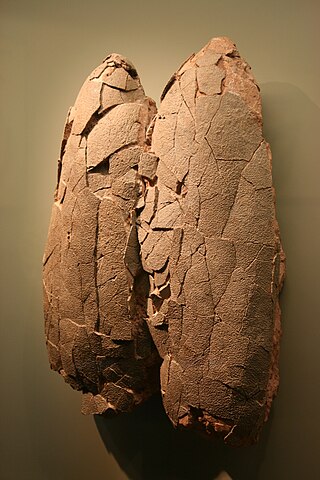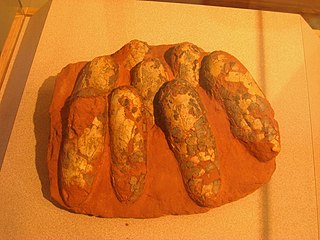
Dendroolithus is an oogenus of Dendroolithid dinosaur egg found in the late Cenomanian Chichengshan Formation, in the Gong-An-Zhai and Santonian Majiacun Formations of China and the Maastrichtian Nemegt and Campanian Barun Goyot Formation of Mongolia. They can be up to 162 mm long and 130 mm wide. These eggs may have been laid by a Therizinosaur, Sauropod, or Ornithopod. The oospecies "D." shangtangensis was originally classified as Dendroolithus, however, it has since been moved to its own distinct oogenus, Similifaveoloolithus. This oogenus is related with embryos of the theropod Torvosaurus
Dictyoolithus is an oogenus of dinosaur egg from the Cretaceous of China. It is notable for having over five superimposed layers of eggshell units. Possibly, it was laid by megalosauroid dinosaurs.

Youngoolithus is an oogenus of dinosaur egg. It is the sole member of the oofamily Youngoolithidae, and consists of a single oospecies: Youngoolithus xiaguanensis. It consists of a single fossil nest of 16 eggs with an associated dinosaur footprint that was first discovered in 1975 in the Majiacun Formation near Houzhuang Village, Henan Province, in the Cretaceous Xiaguan Basin. The eggs are smooth, olive-shaped, and arranged in five rows. It was originally described as being a Faveoloolithid egg, however the nest is arranged quite differently than other members of that family, so it has been moved to its own oofamily, Youngoolithidae.

Faveoolithus is an oogenus of dinosaur egg. The oogenus contains two oospecies, F. ningxiaensis and F. zhangi.

Ovaloolithus is an oogenus of dinosaur egg. Eggs of the genus have been found in China, Mongolia and Utah.
Shixingoolithus is an oogenus of dinosaur egg from the Cretaceous of Nanxiong, China.

Spheroolithus is an oogenus of dinosaur egg.

Macroelongatoolithus is an oogenus of large theropod dinosaur eggs, representing the eggs of giant caenagnathid oviraptorosaurs. They are known from Asia and from North America. Historically, several oospecies have been assigned to Macroelongatoolithus, however they are all now considered to be a single oospecies: M. carlylensis.

Macroolithus is an oogenus of dinosaur egg belonging to the oofamily Elongatoolithidae. The type oospecies, M. rugustus, was originally described under the now-defunct oogenus name Oolithes. Three other oospecies are known: M. yaotunensis, M. mutabilis, and M. lashuyuanensis. They are relatively large, elongated eggs with a two-layered eggshell. Their nests consist of large, concentric rings of paired eggs. There is evidence of blue-green pigmentation in its shell, which may have helped camouflage the nests.
Phaceloolithus is an oogenus of dinosaur egg found in the Fenshui'ao Formation of the Dongting Basin of the Hunan Province of China. The eggs have a subspherical shape, measuring up to 168 mm on the long axis, and having a very thin shell.
Porituberoolithus is an oogenus of dinosaur egg found in the late Campanian Oldman Formation and Dinosaur Park Formation of Alberta, the Fossil Forest Member of the Fruitland Formation in New Mexico, the Upper Shale Member of the Aguja Formation in Texas and Cerro del Pueblo Formation of Mexico. It was originally described as distinct from the Elongatoolithids on the basis of its ornamentation, but it was listed as a member of that oofamily by Wang et al. 2010. It is very similar to Subtiliolithus, but has a thicker shell.

Egg fossils are the fossilized remains of eggs laid by ancient animals. As evidence of the physiological processes of an animal, egg fossils are considered a type of trace fossil. Under rare circumstances a fossil egg may preserve the remains of the once-developing embryo inside, in which case it also contains body fossils. A wide variety of different animal groups laid eggs that are now preserved in the fossil record beginning in the Paleozoic. Examples include invertebrates like ammonoids as well as vertebrates like fishes, possible amphibians, and reptiles. The latter group includes the many dinosaur eggs that have been recovered from Mesozoic strata. Since the organism responsible for laying any given egg fossil is frequently unknown, scientists classify eggs using a parallel system of taxonomy separate from but modeled after the Linnaean system. This "parataxonomy" is called veterovata.
Paraelongatoolithus is a late Cretaceous oogenus of Chinese fossil egg, classified in the oofamily Elongatoolithidae, which represents the eggs of oviraptorosaurs.
Stalicoolithus is an oogenus of dinosaur egg from the Sanshui and Chichengshan Formations of the Tiantai Basin in Zhejiang Province. It is known from a single, complete fossil egg, notable for its spherical shape.
Coralloidoolithus is an oogenus of dinosaur egg from the Tiantai Basin in Zhejiang Province, containing a single known oospecies C. shizuiwanensis. Formerly, it was classified in the oogenus Paraspheroolithus; however, it was considered sufficiently different to be classified in its own genus. C. shizuiwanensis is similar to Stalicoolithus, leading to their classification in the same family, Stalicoolithidae.
Heishanoolithus is an oogenus of Elongatoolithid fossil egg from the Shahai Formation in Liaoning. It is known only from seven eggshell fragments. It is most notable for having a very thin eggshell, the dense covering of nodes on the eggshell surface, and for its relatively thin mammilary layer. While no remains of Heishanoolithus have been associated with skeletal remains, strong evidence links Elongatoolithid eggs to Oviraptorosaurs.

Elongatoolithidae is an oofamily of fossil eggs, representing the eggs of oviraptorosaurs. They are known for their highly elongated shape. Elongatoolithids have been found in Europe, Asia, and both North and South America.
Undulatoolithus is an oogenus of Chinese fossil dinosaur egg belonging to Elongatoolithidae. It is very similar to Macroolithus, but has different ornamentation. Like other elongatoolithids, it was probably laid by oviraptorosaurs.
Dictyoolithidae is an oofamily of dinosaur eggs which have a distinctive reticulate organization of their eggshell units. They are so far known only from Cretaceous formations in China.
Nanhsiungoolithus is an oogenus of dinosaur egg from the late Cretaceous of China. It belongs to the oofamily Elongatoolithidae, which means that it was probably laid by an oviraptorosaur, though so far no skeletal remains have been discovered in association with Nanhsiungoolithus. The oogenus contains only a single described oospecies, N. chuetienensis. It is fairly rare, only being know from two partially preserved nests and a few eggshell fragments.








